#louise albertine
Explore tagged Tumblr posts
Text

Photograph of Princess Albertine of Montenuovo. She was the eldest daughter of William Albert, 1st Prince of Montenuovo, who himself was the son of Marie Louise of Austria.
#albertine of Montenuovo#william albert of montenuovo#marie louise of austria#house of Neipperg-Montenuovo#long live the queue
48 notes
·
View notes
Text
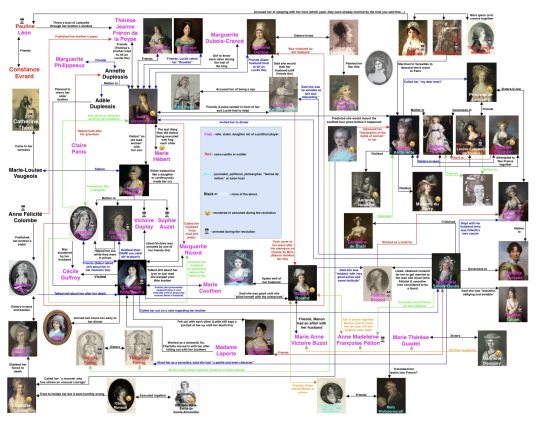
I decided to try this but for the girlies instead.
Are you sure want to click on ”keep reading”?
For Pauline Léon marrying Claire Lacombe’s host, see Liberty: the lives of six women in Revolutionary France (2006) by Lucy Moore, page 230
For Pauline Léon throwing a bust of Lafayette through Fréron’s window and being friends with Constance Evrard, see Pauline Léon, une républicaine révolutionnaire (2006) by Claude Guillon.
For Françoise Duplay’s sister visiting Catherine Théot, see Points de vue sur l’affaire Catherine Théot (1969) by Michel Eude, page 627.
For Anne Félicité Colombe publishing the papers of Marat and Fréron, see The women of Paris and their French Revolution (1998) by Dominique Godineau, page 382-383.
For the relationship between Simonne Evrard and Albertine Marat, see this post.
For Albertine Marat dissing Charlotte Robespierre, see F.V Raspail chez Albertine Marat (1911) by Albert Mathiez, page 663.
For Lucile Desmoulins predicting Marie-Antoinette would mount the scaffold, see the former’s diary from 1789.
For Lucile being friends with madame Boyer, Brune, Dubois-Crancé, Robert and Danton, calling madame Ricord’s husband ”brusque, coarse, truly mad, giddy, insane,” visiting ”an old madwoman” with madame Duplay’s son and being hit on by Danton as well as Louise Robert saying she would stab Danton, see Lucile’s diary 1792-1793.
For the relationship between Lucile Desmoulins and Marie Hébert, see this post.
For the relationship between Lucile Desmoulins and Thérèse Jeanne Fréron de la Poype, and the one between Annette Duplessis and Marguerite Philippeaux, see letters cited in Camille Desmoulins and his wife: passages from the history of the dantonists (1876) page 463-464 and 464-469.
For Adèle Duplessis having been engaged to Robespierre, see this letter from Annette Duplessis to Robespierre, seemingly written April 13 1794.
For Claire Panis helping look after Horace Desmoulins, see Panis précepteur d’Horace Desmoulins (1912) by Charles Valley.
For Élisabeth Lebas being slandered by Guffroy, molested by Danton, treated like a daughter by Claire Panis, accusing Ricord of seducing her sister-in-law and being helped out in prison by Éléonore, see Le conventionnel Le Bas : d'après des documents inédits et les mémoires de sa veuve, page 108, 125-126, 139 and 140-142.
For Élisabeth Lebas being given an obscene book by Desmoulins, see this post.
For Charlotte Robespierre dissing Joséphine, Éléonore Duplay, madame Genlis, Roland and Ricord, see Mémoires de Charlotte Robespierre sur ses deux frères (1834), page 76-77, 90-91, 96-97, 109-116 and 128-129.
For Charlotte Robespierre arriving two hours early to Rosalie Jullien’s dinner, see Journal d’une Bourgeoise pendant la Révolution 1791–1793, page 345.
For Charlotte Robespierre physically restraining Couthon, see this post.
For Charlotte Robespierre and Françoise Duplay’s relationship, see Mémoires de Charlotte Robespierre sur ses deux frères (1834) page 85-92 and Le conventional Le Bas: d’après des documents inédits et les mémoires de sa veuve (1902) page 104-105
For the relationship between Charlotte Robespierre and Victoire and Élisabeth Lebas, see this post.
For Charlotte Robespierre visiting madame Guffroy, moving in with madame Laporte and Victoire Duplay being arrested by one of Charlotte’s friends, see Charlotte Robespierre et ses amis (1961)
For Louise de Kéralio calling Etta Palm a spy, see Appel aux Françoises sur la régénération des mœurs et nécessité de l’influence des femmes dans un gouvernement libre (1791) by the latter.
For the relationship between Manon Roland and Louise de Kéralio Robert, see Mémoires de Madame Roland, volume 2, page 198-207
For the relationship between Madame Pétion and Manon Roland, see Mémoires de Madame Roland, volume 2, page 158 and 244-245 as well as Lettres de Madame Roland, volume 2, page 510.
For the relationship between Madame Roland and Madame Buzot, see Mémoires de Madame Roland (1793), volume 1, page 372, volume 2, page 167 as well as this letter from Manon to her husband dated September 9 1791. For the affair between Manon and Buzot, see this post.
For Manon Roland praising Condorcet, see Mémoires de Madame Roland, volume 2, page 14-15.
For the relationship between Manon Roland and Félicité Brissot, see Mémoires de Madame Roland, volume 1, page 360.
For the relationship between Helen Maria Williams and Manon Roland, see Memoirs of the Reign of Robespierre (1795), written by the former.
For the relationship between Mary Wollstonecraft and Helena Maria Williams, see Collected letters of Mary Wollstonecraft (1979), page 226.
For Constance Charpentier painting a portrait of Louise Sébastienne Danton, see Constance Charpentier: Peintre (1767-1849), page 74.
For Olympe de Gouges writing a play with fictional versions of the Fernig sisters, see L’Entrée de Dumourier à Bruxelles ou les Vivandiers (1793) page 94-97 and 105-110.
For Olympe de Gouges calling Charlotte Corday ”a monster who has shown an unusual courage,” see a letter from the former dated July 20 1793, cited on page 204 of Marie-Olympe de Gouges: une humaniste à la fin du XVIIIe siècle (2003) by Oliver Blanc.
For Olympe de Gouges adressing her declaration to Marie-Antoinette, see Les droits de la femme: à la reine (1791) written by the former.
For Germaine de Staël defending Marie-Antoinette, see Réflexions sur le procès de la Reine par une femme (1793) by the former.
For the friendship between Madame Royale and Pauline Tourzel, see Souvernirs de quarante ans: 1789-1830: récit d’une dame de Madame la Dauphine (1861) by the latter.
For Félicité Brissot possibly translating Mary Wollstonecraft, see Who translated into French and annotated Mary Wollstonecraft’s Vindication of the Rights of Woman? (2022) by Isabelle Bour.
For Félicité Brissot working as a maid for Louise Marie Adélaïde de Bourbon, see Mémoires inédites de Madame la comptesse de Genlis: sur le dix-huitième siècle et sur la révolution française, volume 4, page 106.
For Reine Audu, Claire Lacombe and Théroigne de Méricourt being given civic crowns together, see Gazette nationale ou le Moniteur universel, September 3, 1792.
For Reine Audu taking part in the women’s march on Versailles, see Reine Audu: les légendes des journées d’octobre (1917) by Marc de Villiers.
For Marie-Antoinette calling Lamballe ”my dear heart,” see Correspondance inédite de Marie Antoinette, page 197, 209 and 252.
For Marie-Antoinette disliking Madame du Barry, see https://plume-dhistoire.fr/marie-antoinette-contre-la-du-barry/
For Marie-Antoinette disliking Anne de Noailles, see Correspondance inédite de Marie Antoinette, page 30.
For Louise-Élisabeth Tourzel and Lamballe being friends, see Memoirs of the Duchess de Tourzel: Governess to the Children of France during the years 1789, 1790, 1791, 1792, 1793 and 1795 volume 2, page 257-258
For Félicité de Genlis being the mistress of Louise Marie Adélaïde de Bourbon’s husband, see La duchesse d’Orléans et Madame de Genlis (1913).
For Pétion escorting Madame Genlis out of France, see Mémoires inédites de Madame la comptesse de Genlis…, volume 4, page 99.
For the relationship between Félicité de Genlis and Louise de Kéralio Robert, see Mémoires de Madame de Genlis: en un volume, page 352-354
For the relationship between Félicité de Genlis and Germaine de Staël, see Mémoires inédits de Madame la comptesse de Genlis, volume 2, page 316-317
For the relationship between Félicité de Genlis and Théophile Fernig, see Mémoires inédits de Madame la comptesse de Genlis, volume 4, page 300-304
For the relationship between Félicité de Genlis and Félicité Brissot, see Mémoires inédites de Madame la comptesse de Genlis, volume 4, page 106-110, as well as this letter dated June 1783 from Félicité Brissot to Félicité Genlis.
For the relationship between Félicité de Genlis and Théresa Cabarrus, see Mémoires de Madame de Genlis: en un volume (1857) page 391.
For Félicité de Genlis inviting Lucile to dinner, see this letter from Sillery to Desmoulins dated March 3 1791.
For Marinette Bouquey hiding the husbands of madame Buzot, Pétion and Guadet, see Romances of the French Revolution (1909) by G. Lenotre, volume 2, page 304-323
Hey, don’t say I didn’t warn you!
#french revolution#frev#marie antoinette#pauline léon#claire lacombe#théroigne méricourt#reine audu#charlotte robespierre#éléonore duplay#élisabeth duplay#élisabeth lebas#lucile desmoulins#louise de kéralio#félicité de genlis#félicité brissot#mary wollstonecraft#manon roland#madame royale#charlotte corday#albertine marat#simonne evrard#catherine théot#madame élisabeth#sophie condorcet#françoise duplay#cécile renault#gabrielle danton#louise sebastien danton#theresa tallien#theresa cabarrus
198 notes
·
View notes
Text

Eté 1932 - Champs-les-Sims
3/6
Adelphe vit aussi quelques déboires en ce moment. Ce qui m'a alerté, c'est le jour où Antoine m'a fait remarqué avec humour qu'on ne l'avait jamais autant vu que depuis qu'il avait quitté la maison. Même en dehors du travail, il a toujours eu l'habitude de venir voir les filles de temps à autres, mais c'est devenu très régulier, d'autant plus depuis que la petite Louise est là.
Mon oncle peut être connu comme une véritable tombe, tu propre aveu de ma mère qui a reconnu avoir échoué à lui extorquer ses secrets, mais étrangement, je n'ai pas eu à le cuisiner trop longtemps. Je me suis tant confiée à lui qu'il a du lui même se sentir en confiance avec moi, et cela fait environ un an que je suis devenue une sorte de confidente pour moi.
#lebris#lebrisgens5#history challenge#legacy challenge#decades challenge#nohomechallenge#sims 3#ts3#simblr#sims stories#Arsinoé Le Bris#Lucien Le Bris#Adelphe Barbois#Elisabeth Le Bris de Chastel#Marc-Antoine Le Bris#Anna Le Bris de Chastel#Louise Josette Le Bris#Albertine Maigret
9 notes
·
View notes
Text

And a Happy birthday to Viviane Katrina Louise Albertine (born 1 December 1954) is an Australian-born British musician, singer, songwriter and writer. She is best known as the guitarist for the punk band the Slits from 1977 until 1982, with whom she recorded two studio albums. Prior to joining the Slits, Albertine was a member of the Flowers of Romance.🎂
143 notes
·
View notes
Text
70 years young 😍
Happy Birthday to Viviane Katrina Louise "Viv" Albertine, Australian-born British singer and songwriter, guitarist for the English punk group the Slits and member of the Flowers of Romance, born on this day in 1954, Sydney

#punk#punks#punkrock#womenofpunk#vivalbertine#theslits#punklegends#oldschoolpunk#history#punkrockhistory#otd
94 notes
·
View notes
Text
Women artists in Napoleonic France

(Young women copying: ‘Love begging Venus to forgive Psyche’ which was displayed at the 1808 Salon. Sketch by Georges Rouget)
Quotes from an article about women’s participation in the art world during the Napoleonic era.
Article:
Heather Belnap Jensen, “The Journal des Dames et des Modes: Fashioning Women in the Arts, c. 1800-1815,” Nineteenth-Century Art Worldwide 5, no. 1 (Spring 2006) (source)
“More and more women artists began exhibiting their work in public venues and receiving recognition for their contributions at this time. While only three women artists had participated in the 1789 biennial Salon, fifty participated in the Salon of 1806–an increase in women’s participation of over 1600 percent in seventeen years.”
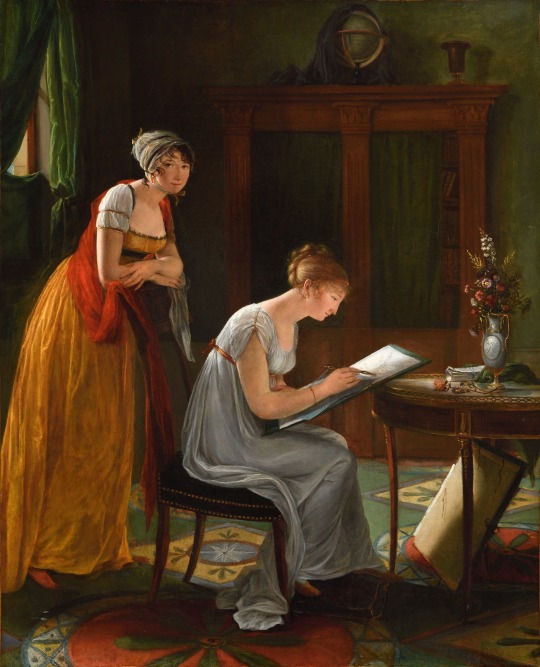
(Woman artist giving a drawing lesson — Self-portrait, 1810, by Louise-Adéone Drölling)
“We see a move away from the emphasis on the public sphere to the private space as motifs, intimating a valorization of a woman’s world. While history painting, which played such a crucial role in Revolutionary visual culture, remained the privileged genre at the turn of the century, the rise in portraiture, landscape, and genre painting in Napoleonic France indicates this shift in values.”
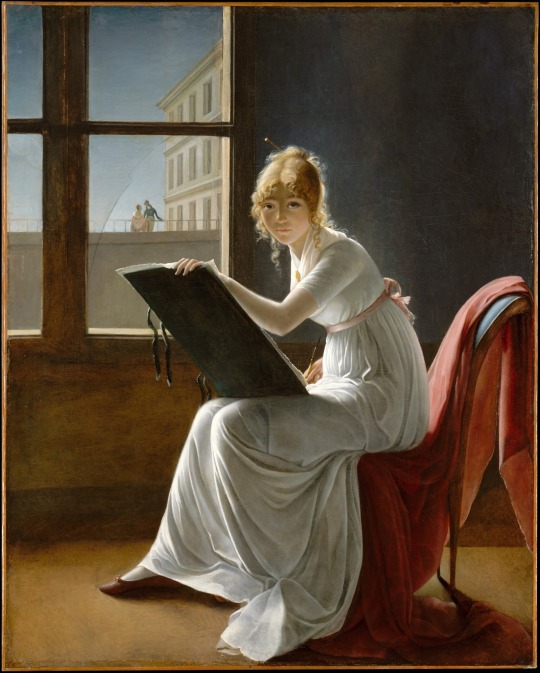
(Young Woman Drawing—Portrait of Charlotte du Val d'Ognes, 1801, by Marie-Denise Villers)
“Women’s journals, which often published art-related materials, have been largely overlooked in discussions of developments in late eighteenth-and early nineteenth-century French visual culture. This is surprising, given that bibliographies on art criticism of this period frequently cite items from these publications.”
One of the most influential women’s journal of the period was Journal des Dames et des Modes. It was created by Jean-Baptiste Sellèque and Pierre de La Mésangère in 1797 and continued until 1839.
“La Mésangère’s key collaborator during the Napoleonic period was a woman, Albertine Clément, née Hémery, a well-known figure in both journalistic and cultural circles in post-Revolutionary France, and that several women were regular contributors to this journal during this era.”
Annemarie Kleinert did a study on the journal:
“She determined that the journal targeted bourgeois women between the ages of 18 and 40 years old who could afford the annual subscription rate of 10 livres, and that the majority of subscribers during the period from 1800 to 1815 were from the provinces.”

(Portrait of a Young Woman Drawing Herself, early 1800s, by Louis-Léopold Boilly)
Interest from women in creating their own designs:
“Fashion plates that accompanied each issue of this journal gave visual testimony to this heightened interest in women’s artistic engagement. Indeed, women in fashion plates were sometimes presented in the act of sketching and drawing, as shown in a plate that appeared as an insert in an 1802 issue of the Journal des Dames et des Modes.”
The act of women creating art was compared to motherhood. In that way, women were encouraged to make art, but in terms which enforced traditional and patriarchal ideas:
“Furthermore, the vocabulary used by the author stresses the ways in which artistic creativity mirrors childbirth and elicits feelings of exaltation over one’s art that are similar to those evoked by motherhood when he writes that ‘she smiles at the objects which are born of her colors’ and calls the site of her production a ‘creative space.’”
There were opportunities for women to paint nude subjects for classical style art:
“Recent scholarship suggests that there were opportunities for such study in the Napoleonic era. By 1800, female students could attend anatomy classes given by the surgeon Sue and also by the École du Modèle Vivant at Versailles, and artist Adele Romilly reported that David, Régnault, and Guérin all provided mixed studios that offered courses on life drawing from the nude.”
One of the claims made against the women’s journals is that they were sexist. The author points out that it’s more complicated and not entirely true. The journals included laudatory reviews of paintings by female artists at the salons, biographies of women artists, such as Angelica Kauffmann, and published excerpts of pamphlets written by women, such as Angélique Mongez.
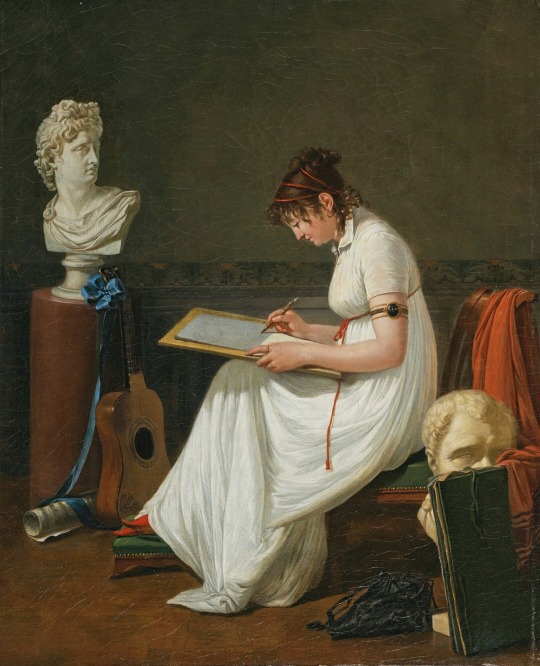
(Portrait of an Artist Drawing after the Antique, c. 1800s, Jean François Sablet)
However, the author also says there was a lot of anxiety about the increase in female participation in the art world, both as creators and as spectators. There were articles describing women at museums in derogatory terms. One in particular described a young girl being overcome by emotion at the sight of the statue of Apollo Belvedere and creating such a large scene that she had to be dragged away in tears.
These articles imply that women spectators had become dominant enough that it could inspire critics.
Women had become so important in the art world that a really unique phenomenon happened:
“Roger Bellet has demonstrated that there are known instances in late eighteenth-and early nineteenth-century France when men published under a female pseudonym.”
Many of the top artists who were admired in the era were women such as Élisabeth Louise Vigée-Lebrun, Marguerite Gérard, Constance Mayer, Adèle Romany, Adélaïde Labille-Guiard, Pauline Auzou, Jeanne-Elisabeth Chaudet, Marie-Guillemine Benoist, Constance Marie Charpentier and many others.
#art#women’s art#women artists#napoleonic era#napoleonic#mine#fashion#writing#first french empire#napoleon bonaparte#quotes#ref#reference#Journal des Dames et des Modes#19th century#1800s#fashion history#historical fashion#history of fashion#french empire#france#history#french revolution#frev#women’s history#womens art#women in art#women painters#fashion plates
67 notes
·
View notes
Text

Princess Louise of Hesse-Darmstadt (1761–1829)
Artist: Johann Friedrich Dryander (German, 1756–1812
Date: 1783
Medium: Pastel on paper
Collection: Schlossmuseum Darmstadt, Darmstadt, Germany
Princess Louise Henriette
Princess Louise Henriette Karoline of Hesse-Darmstadt (15 February 1761 – 24 October 1829), was the first Grand Duchess of Hesse and by Rhine by marriage.
Louise was a daughter of Prince George William of Hesse-Darmstadt (1722–1782) from his marriage to Countess Maria Louise Albertine of Leiningen-Dagsburg-Falkenburg (1729–1818), daughter of Count Christian Karl Reinhard of Leiningen-Dachsburg-Falkenburg-Heidesheim.
The princess was in 1770 in the entourage of Marie Antoinette, as they traveled to France for her marriage. Louise exchanged letters with the French queen until 1792.
Louise married on 19 February 1777 in Darmstadt, her cousin the then hereditary prince Louis I of Hesse-Darmstadt (1753–1830). Her husband ruled Hesse-Darmstadt from 1790 as Landgrave Louis X and from 1806 as Ludwig I, Grand Duke of Hesse and the Rhine.
Louise spent the summer months since 1783 in the State Park Fürstenlager, and died there in 1829. Here provided charity to the population Auerbach. The Grand Duchess was described as amiable and revered by the nation. Johann Wolfgang von Goethe stayed at her court and Friedrich Schiller read from his Don Carlos in her salon. It was said that Napoleon Bonaparte promised the beautiful Louise, whom he believed to be one of the cleverest women of her time, that he would give her a crown.
#portrait#princess#princess louise of hesse-darmstadt#painting#grand duchess of hesse#german nobility#woman#white dress#open book#flowers#bows#table#german princess#pastel on paper#fine art#artwork#german culture#german history#bell#johann friedrich dryander#german painter#german art#18th century painting#european art
2 notes
·
View notes
Text
Very mediocre (and horrible) quote from Buzot about Pache , his family and especially some reflections of Pache's friendships and family
Here is what I found on a website in Buzot's memoirs that, for his honor, I hope he did not actually say. Warning: misogynistic language ahead that may make your eyes bleed:
"Pache's children, his daughters, ran like madmen to the places where murder and pillage were preached with the most impudence, and they were often seen in so-called fraternal embraces, warming themselves up for the disgusting orgies."
Anyway, let's move on from this point. Pache only had one daughter, Sylvie, but perhaps Buzot mentioned a stepdaughter. In any case, Sylvie was only 16 at the time of these events, so the insult is all the more serious (according to Mathilde Larrère, Sylvie Audouin was a fervent young Hébertist, born a year after Louise Gely, and we can say that she was an ultra-revolutionary, a sort of reverse Louise Gely which Danton had to marry her through a refractory priest) . Treating an adult this way is insulting even more so when it's a teenager who will have an even harder time taking this insult. We also know that she married François Xavier Audouin, an important Jacobin and Hébertist (with Santerre and Hébert as witnesses, it seems) who worked at the Ministry of War. She was only 16 when she married. It seems Sylvie may have suffered from xenophobia, like her father, because he was Swiss, and he often took his children there before 1792 (or was it 1789? I can't remember). Louis de Launay, in Monge's biography, mentions that she argued violently about the execution of the Hébertists with Carnot and Prieur Claude-Antoine in Monge's salon, but honestly, there is no proof of this. It’s more likely that the arrest of Pache and François Xavier Audouin was entirely political (Frankly, settling scores over a dispute by having people arrested was not in the style of the Committee of Public Safety or the Convention). One day, I should tell the story of Pache and his childrens. It would also be interesting to explore the Pache-Monge-Carnot friendship triangle that I’ve read about in some biographies. Or Audouin-Monge-Bonaparte (maybe that's why François Xavier Audouin, one of the "star" opponents of the Directory and Sieyès, was able to escape the deportation of the Jacobins, or why Bonaparte wanted Pache’s cooperation in vain because Audouin was initially on the deportation list ). I wonder if Sylvie was arrested by Bonaparte's police, like Marie-Anne Babeuf temporarily, Simone Evrard, or Albertine Marat, or if she was “only” monitored like the other wives of the Jacobins (for example Mrs. Dufour) . In any case, this would mark the end of Audouin's political career. He became a royalist in 1816, probably due to the oppressive laws, even though he did not renounce his revolutionary friendships like Pache did. I wonder if Sylvie's death four years later was linked to this disillusionment. The hardships she endured, the execution of the Hébertists, then the arrest of her father and her husband, the fact that her father was apparently persecuted by muscadins, the fights that her husband (and surely she was since Mathilde Larrère said that she was a fervent Hébertist) against the Directory, the fact that her husband narrowly escaped deportation (and possibly death) under Bonaparte, possibly having seen Jacobin friends deported or executed, having retired from political life, seeing her brother rally to Bonaparte, the restoration of the Bourbons and finally that her fervent Hébertist and Jacobin husband converted to royalism (due to the pressure of the laws of 1816) did not precipitate her into her grave by disappointments (it is possible that she simply died of illness or she approved the choice of her husband). For the moment I have difficulty getting more information on the Audouin couple. Too bad because historian Bernard Gainot claims that just like Victor Bach, Antonelle, Felix Le Peletier, René Vatar, the Babeuf couple, Jorry (maybe even Rossignol), Buonarotti, Topino-Lebrun, ,Bernard Metge they were the best known in the period of the neo-Jacobins against the Directory , Sieyes and until 1802, the date of the end of the political career of Xavier-François Audouin (plus historians like Mathilde Larrère concerning at least Sylvie Audouin despite her young age at the time and Bloche say that they were also well known during the French Revolution).
To summarize, I’d like to explore the Pache-Monge-Carnot friendship triangle, considering that Pache and Carnot did not get along at all from what I understand (and this doesn't surprise me; Pache was somewhat close to the Hébertists even if he did not take part in the insurrection, called for calm and did not testify in favor of Momoro, Hébert, Vincet, Ronsin and Chaumette , while Carnot was not at all close to the hébertists ,was opposed to them and vice versa ). And one day, I should write a post about Pache.
3 notes
·
View notes
Text
Lecture Notes MON 16th OCT
Masterlist
BUY ME A COFFEE
Doing Art History: Drawing/Works on paper.
Oeuvre: the artworld of that time. The body of work by a painter, composer, or author.
Drawing was and has always been the first step into becoming an artist, it is the most fundamental and important aspect of any artistic study or development. To know your fundamentals, the figure, perspective, and weight/shading. Historically this is the first step any artist took, before developing into their preferred medium.
Observe these drawings/sketches and paintings; consider the materials, their effect and product.



Jean-Auguste-Dominique Ingres, Vicomtesse Othenin d'Haussonville, nee Louise Albertine de Broglie, study, ca. 1845, graphite, with white heightening, on paper, France, Musée de Carpentras.
Colourism – (not to be confused with the discrimination based on skin colour) Specifically in painting, it is a style of painting characterised by the use of intense colour, which becomes the dominant feature of the resultant work of art, mostly influential in the French impressionism movement of the 19th century.
Also: a person who uses colour in s particular way, draws attention to the colour use.

HILAIRE-GERMAIN-EDGAR DEGAS, WOMAN STANDING IN A BATHTUB C. 1890–92, charcoal with stumping on beige wove paper, 43.2 x 29.5 cm, Sterling and Francine Clark Institute

Edgar Degas After the Bath, Woman Drying Herself, c. 1890-95 Pastel on wove paper laid on millboard. 103.5 x 98.5 cm. The National Gallery, London. Bought, 1959. Photo: © The National Gallery, London
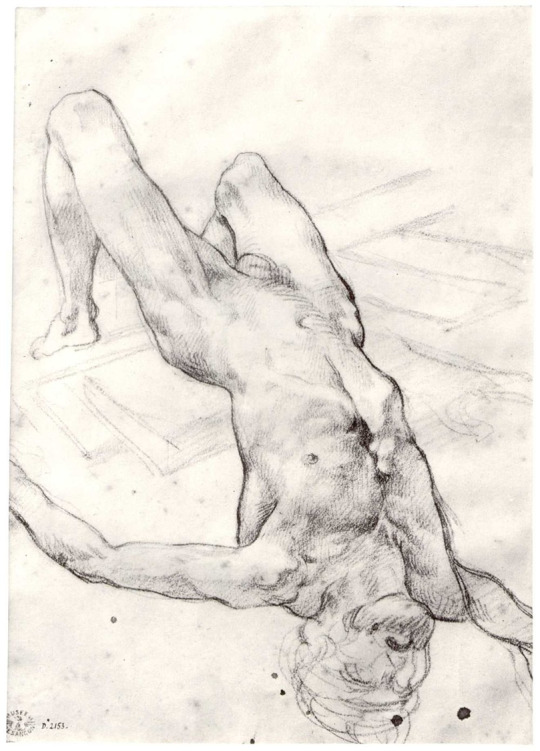
Théodore Géricault, Study for the Raft of Medusa, 1818, charcoal on paper, Paris, Musée du Louvre.
Observe the contour line (the darker outline line), surrounding the body. Note the twist and strain of the muscles and exaggeration of line and pose to create drama on the paper. Also note the materials used. Charcoal: a material that possesses a short life on paper without additives to preserve it. Something that smudges easily. Perhaps to quickly capture the body and idea and shading.
The Male nude – which surprisingly are the most common nude that exists in the western world. And this is because the basic fundaments were learnt from drawing casts, from the ancient world, or drawing from other works of art. Sketching development and a skill development, meant drawing bodies and getting to access to more complex forms to keep learning.
The RA is doing an exhibition on Impressionist on paper, which from the photos of artworks in this post, I recommend going to and seeing and judging for yourself, the use of materials and their effects.
On Degas and pastels: you can over saturate paper with pastels, muddying the colour. Critics of Degas spoke out, how his portrayal of bodies appear bruised. Degas was less interested in accuracy, more into the exploration of light on the body, the illumination, and the space it inhabits.
Genres of painting: Landscape, Portrait, Still life, Genre, Historical, Allegorical:
Allegorical paintings covered mythos. These were most prominent and popular when the state collected paintings, rather than when commissions came into prominence, and private ownership of painting rose.
Impasto: when paint stands off from the canvas. An Italian word for “mixture,” used to describe a painting technique wherein paint is thickly laid on a surface, so that brushstrokes or palette knife marks are visible. A pastose surface is one that is thickly painted.
19th century: paints in tubes begin to make an appearance.
Plain air: painting outside, open air painting. A common impressionist's expression.

Claude Monet Cliffs at Etretat: The Needle Rock and Porte d’Aval, Pastel on wove paper, c. 1885. 39 x 23 cm. National Galleries of Scotland. Accepted in lieu of Inheritance Tax by H M Government from the estate of Miss Valerie Middleton and allocated to the Scottish National Gallery, 2016
Drawings always have a subjective idea of being ‘finished’ surrounding them. A rising problem surrounding the impressionist artists was critics perceptions of the artworks seeming unfinished, which could decrease a value of an artwork.

Berthe Morisot, At the Beach in Nice, 1882, pencil and watercolour, Stockholm, Nationalmuseum.
Note the signing of this particular artwork, in the bottom left corner. A tendency that arose after an artist died and their work became more famous or popular, their families would sign the work in their name.
Moreover, looking at this artwork it may surprise some to know that watercolour is considered a less prestigious material to use. As opposed to oil painting, which carries a greater prestige due to its difficulty to use and master. Leaving less room for imperfections. As a snide response to the impressionist movement, critics suggested that these artist under this movement, stick to and use watercolour.
Consider critics opinions of materials and how that translates to accessibility and intension.
Watercolour is actual a far more accessible material than oil painting and can give you a great finish, especially for artists that were painting on open air and their surroundings live.
#art#artwork#writing#essay#paintings#art tag#art hitory#art exhibition#art show#art gallery#lecture#essay writing#writers#creative writing#writeblr#writers on tumblr#writers and poets#education#learn#teaching#learning#students#educators#artists#artists on tumblr#drawings#illustration#art style#history#histoire
9 notes
·
View notes
Text

Antoine Pesne, 1683-1757
Portrait of Louise Albertine Baroness von Grappendorf (1729-1753) as Flora, ca.1750
Collection Friedrichsfelde Castle, Standort des Stadtmuseums Berlin
2 notes
·
View notes
Text
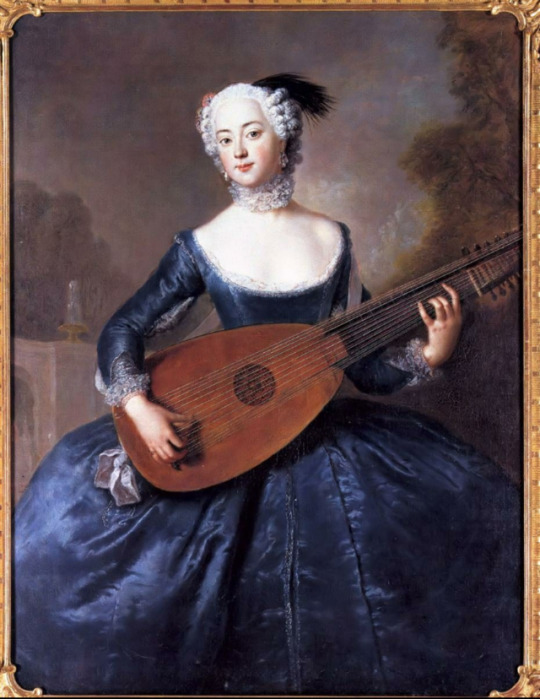
Antoine Pesne (1683-1757), Portrait d'Eleonore Louise Albertine, comtesse von Schlieben-Sanditten, épouse de Dietrich Cesarion, 1745
0 notes
Text
In the 18th century.
Biography of the translators of the 18th century.

Giuseppa Barbapiccola (1702-1740), an Italian philosopher, translated French philosopher Descartes’ “Principles of Philosophy”. She demonstrated that Descartes created a philosophy praising the female intellect, and defended the right for women to learn. Her goal was to inspire women to educate and empower themselves. Her translation included a history of women’s learning and a history of philosophy.
Ignacy Krasicki (1735-1801), a Polish poet known as Poland’s La Fontaine (a wellknown French fabulist), translated many works by classical poets (Plutarch, Anacreon, Hesiod, Theocritus) and modern poets (Boileau, Dante, James Macpherson). His translations contributed to the Enlightenment, a cultural, philosophical and literary movement throughout Europe.
Claudine Picardet (1735-1820), a French chemist, translated the scientific literature of her time in chemistry and mineralogy. A female chemist working alongside men was highly unusual at the time. She was proficient in five foreign languages (English, German, Italian, Latin, Swedish), which was highly unusual too. Her translations contributed to the scientific knowledge gathered during the Chemical Revolution, a movement led by French chemist Antoine Lavoisier.
Johann Heinrich Voss (1751-1826), a German poet, produced a 9-volume translation of Shakespeare’s plays with the help of his sons Heinrich and Abraham. Another German translation by August Schlegel (1767-1845), a leader of Jena Romanticism (the first phase of Romanticism in German literature), turned Shakespeare’s plays into German classics. Shakespeare’s plays were then translated into Swedish by the linguist Carl August Hagberg (1810-1864), who was a strong advocate of English and French literature at a time when Swedish universities were dominated by German influences.
Sarah Austin (1793-1867), an English writer, Louise Swanton Belloc (1796-1881), a French writer, Therese Albertine Luise Robinson (1797-1870), a German writer, and Mary Howitt (1799-1888), an English poet, translated a number of contemporary literary works for them to reach a wider audience. Mary Howitt translated into English some novels by Swedish feminist writer Fredrika Bremer while Louise Swanton Belloc translated into French “Uncle Tom’s Cabin” by American writer Harriet Beecher Stowe, a novel that described the harsh living conditions of enslaved African-Americans.
0 notes
Text

Albertine von Montenuovo, eldest child and only surviving daughter of Marie Louise of Austria and Adam Albert von Neipperg.
#Albertine von Montenuovo#albertine von Neipperg#marie louise of austria#Adam Albert von Neipperg#museo glauco lombardi#long live the queue
13 notes
·
View notes
Text



Eté 1934 - Champs-les-Sims
2/5
!! Ces dialogues ont été écrits pour essayer de retranscrire le niveau de langage d'un enfant de trois ans. Navrée si il n'est pas très clair. Une version plus lisible est dispo en bas. !!
Tu as sans doute déjà remarqué que j'ai également répondu à ta petite soeur. C'est une jeune femme adorable qui a simplement besoin de s'épancher un peu, et je suis contente de voir que cela lui fait plaisir. Je sais que c'est parfois difficile de le faire avec ses proches. Ma propre mère m'a parfois reproché de ne pas assez me confier à elle. Je pense qu'elle aurait aimé davantage de proximité. Il faut dire qu'en face, elle avait Oncle Adelphe, qui avait autrefois une relation presque fusionnelle avec ses enfants, surtout avec Alexandre, ce qui est difficile à imaginer aujourd'hui.
D'ailleurs, il semble qu'Antoine et Ange se soient lancées dans une espèce de compétition de meilleur père en imitant Adelphe. Cela reste amical heureusement. Je n'ai jamais vu des hommes aussi investis dans la vie de leur progéniture. Quand il rentre le soir, Antoine demande à Louise de lui raconter sa journée en détail, et il fait preuve d'une infinie patience pendant que la petite bégaye, bute sur les consonnes ou cherches ses mots pendant de longues secondes. Même Ange n'a jamais eu une telle patience.
En réponse, mon mari s'est lancé à corps perdu dans les études de nos filles et a fait des mathématiques son nouveau cheval de bataille. Cela a valu aux filles les félicitations de Mademoiselle Yvain.
Antoine a surenchérit en faisant apprendre à sa fille des mots comme "prolétariat", "capital" ou encore "Lénine". Louise a encore du mal à prononcer les sons en "l", alors ça a été assez laborieux. C'est une plaisanterie plus ou moins amicale entre Antoine et Ange, le premier reprochant au second son manque de conscience politique. Aurore y a mis fin quand la petite s'est mise à bégayer "Vive le camarade Staline." Ma belle-soeur n'aime pas qu'on répète des choses qu'on ne comprend pas, exactement ce qu'était en train de faire Antoine avec leur fille.
Transcription :
Louise « Puis on a lu l‘histoire et Maman a dit d’aller jouer avec Elisabeth. »
Marc-Antoine « Et bien dis moi, ça en fait une journée bien remplie. Et ça t’as plu ma grande ? »
Louise « Oui. Et Papa y fait quoi au travail ? »
Marc-Antoine « Moi ? Oh, tu sais ce n’est pas très intéressant. »
Louise « Pourquoi tu vas au travail alors��? Maman dit que c’est important ton travail. »
Marc-Antoine « Bon alors si Maman le dit… Et bien, Papa aide les gens. Enfin, il essaie. Mon travail, c’est d’essayer de régler les problèmes au village. »
Louise « Pourquoi ? »
Marc-Antoine « Il faut bien que quelqu’un le fasse non ? Je pense que je suis assez utile. Et puis, Papa veut que tous les gens aillent bien. »
Louise « Tu fais comment ? »
Marc-Antoine « Il faut que personne ne sois dans le besoin. Et dans l’idéal, il faudrait que chacun ait droit à la même chose. Tu sais, comme quand tu prend le goûter avec tes cousines, vous avez droit à la même chose. »
Louise « C’est pas vrai ! Pourquoi moi je peux pas avoir la fourchette ? »
Marc-Antoine « Tu es encore trop petite mais… oh ce n’est pas un bon exemple… Tu es peut-être encore un peu petite pour comprendre. Mais dis toi simplement que Papa veut que tous les gens puissent être égaux et qu’il n’y ait plus ni riches ni pauvres. »
Louise « Et c’est bien ça ? »
Marc-Antoine « Oui, c’est bien. Demande à Maman si tu veux. »
Louise « Maman elle pense ça aussi ? »
Marc-Antoine « Oui. Maman et Papa sont mariés parce qu’ils s’aiment mais aussi parce qu’ils pensent la même chose. »
Louise « … »
Marc-Antoine « Louise ? »
Louise « Maman elle pense que je peux avoir une fourchette aussi pour manger. Alors, tu es d’accord ? »
Marc-Antoine « Petite futée… C’est bien la fille de son père celle-là... »
#lebris#lebrisgens5#history challenge#legacy challenge#decades challenge#nohomechallenge#sims 3#ts3#simblr#sims stories#Arsinoé Le Bris#Lucien Le Bris#Louise Josette Le Bris#Marc-Antoine Le Bris#Aurore Laroche#Ange de Chastel#Anna Le Bris de Chastel#Elisabeth Le Bris de Chastel#Adelphe Barbois#Alexandre Barbois#Dolorès Le Bris#Albertine Maigret#Catherine Yvain
16 notes
·
View notes
Text

And a Happy birthday to Viviane Katrina Louise Albertine (born 1 December 1954) is an Australian-born British musician, singer, songwriter and writer. She is best known as the guitarist for the punk band the Slits from 1977 until 1982, with whom she recorded two studio albums. Prior to joining the Slits, Albertine was a member of the Flowers of Romance.🎂
0 notes
Text
Happy Birthday to Viviane Katrina Louise "Viv" Albertine, Australian-born British singer and songwriter, guitarist for the English punk group the Slits and member of the Flowers of Romance, born on this day in 1954, Sydney

#punkrock #womenofpunk #vivalbertine #theslits #otd
38 notes
·
View notes